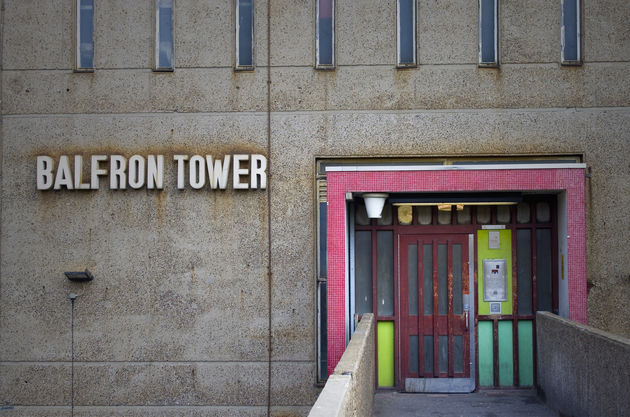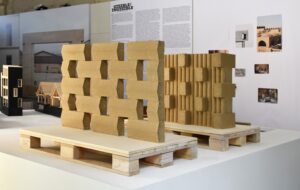 Balfron Tower entrance door. Photo by Graeme Maclean
Balfron Tower entrance door. Photo by Graeme Maclean
Ernö Goldfinger’s high-rise residential block in Poplar, East London was designed as a solution to London’s post-war housing problems
Notable for its fortress-like separate service tower, Balfron Tower was grade II listed in 1996 to save it from demolition. Within the last decade its original residents have been bought out to make room for a massive internal renovation that is transforming the social housing into luxury apartments.
Designed by Hungarian architect Ernö Goldfinger in the late 1960s for the London County Council, the Balfron Tower was built for the poorer community of East London. It formed part of the Brownfield Estate, a trio of social housing buildings designed by Goldfinger. It was one of a wave of significant Brutalist structures of the period, including the Barbican Centre in the City of London and the Heygate Estate in Walworth.
At the time of construction, the 26-storey, 84-metre high block was one of the tallest residential blocks in Europe. Goldfinger hoped to transform the area’s urban sprawl into a neat, vertical neighbourhood. An avid Marxist, he focused on designing elements that would help create communities inside the building.
 Balfron Tower side view. Photo by Graeme Maclean
Balfron Tower side view. Photo by Graeme Maclean
Goldfinger dramatically separated the services from the accommodation, visibly splitting the building in two and housing the shared utilities in a separate tower. This tower contained the lifts and staircases, as well as laundry and waste chutes. A pattern of thin windows allows light into the service tower and the boiler room is located at the top.
Goldfinger also demarcated the internal function of the space on the external facade: the public corridors feature small, vertical windows whereas the flats have larger, broader windows. Passersby can see this visually language from the street. Horizontal bands of spacious balconies run along the west-facing facade.
The service tower connects to the residential flats via eight bridges, a form of the ‘streets in the sky’ favoured by several Brutalist architects. Goldfinger devised an unconventional system of access to the flats, where elevators only served every third floor. This meant that every other floor could run the width of the building without allocation of space for public movement. Once the inhabitants enter their private properties, internal staircases take them up and down to additional floors of their own apartments.
Goldfinger was fascinated by understanding the experience of living with these staggered entrances so high above the ground, and even moved into flat 130 with his wife for a brief period in 1968. During this time he held extravagant parties for his neighbours, interviewing them extensively over what they liked and disliked about living there. He used his learnings in his future designs.
Goldfinger’s Carradale House stands adjacent to Balfron, almost like an extension. It was completed just after Balfron with some small improvements in the design, made as the architect assessed the success of Balfon. Much lower than its neighbour, Carradale House is only 37 metres high, but also features sky bridges on every third floor and south-facing balconies.
 Balfron Tower. Photo by Sebastian F
Balfron Tower. Photo by Sebastian F
Design elements of Balfron are repeated in even-more famous Trellick Tower in Westbourne Grove, West London which Goldfinger designed and built almost immediately after Balfron, but with adaptions he implemented based on learnings from Balfron.
In 2007 the Tower Hamlets Council transferred the building to the housing association HARCA, who initiated a tower transformation in 2011. Working in partnership with high-end developer Londonewcastle, the restoration and refurbishment of the tower will preserve the listed exterior while upgrading the services and homes.
With its proximity to Canary Wharf, the location has a high allure, and price tag on the new luxury units is a long way from Goldfinger’s original clientele. In 2015 there was a campaign to keep 50 percent of Balfron as council housing, but it was unsuccessful. The rennovation will entirely change the character of a building, turning something initially created with socialist principles into a luxury commodity.

















